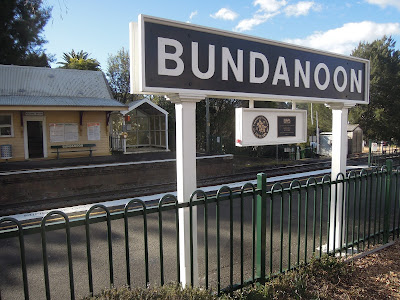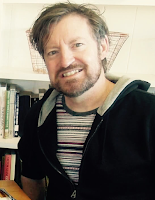Part 2: Bundanoon and the Sunnataram Forest Monastery
I'm currently in Australia visiting family and friends . . . and documenting my experiences in a series of posts labeled "Australian Sojourn – Winter 2017." This series begins here.
In this latest post I share some more images and commentary on my recent visit to the Southern Highlands and Tablelands of New South Wales. This post focuses on time spent in Bundanoon and at the Sunnataram Forest Monastery. (A previous post focused on Exeter and Mt. Alexandra.)
Above and below: The Southern Highlands village of Bundanoon – Saturday, July 29, 2017.
Bundanoon is an Aboriginal name meaning "place of deep gullies" and was formerly known as Jordan's Crossing. Bundanoon is colloquially known as Bundy (also spelt Bundi). It has a population of around 2,700.
It may be winter in Australia, but a number of native plants are beginning to flower and blossom, including the wattle (above) and the bottlebrush (below)
Above, right and below: On Saturday, July 29, I visited with my friends Kerry and Max the Sunnataram Forest Monastery, located just outside of Bundanoon. It's a Theravada Buddhist monastery in the Thai Forest Tradition.
Kerry and I last visited Sunnataram in 2006. (For images and commentary on this visit click here.)
Above: The Sunnataram Forest Monastery’s Gratitude Pagoda.
Rising to a height of 18 metres, the Gratitude Pagoda has two chambers: one in the ground floor level of the building and another in the smaller second floor level. Both chambers enshrine the relics of the Buddha and other enlightened monks who lived in India over two thousand years ago.
The exterior wall of the first floor of the Pagoda contains representations of the Buddha from every Buddhist country in the world.
Of the many representations of the Buddha that adorn the Gratitude Pagoda, my favorite was the one above from Cambodia.
Left: I think it is the eyes that do it for me!
. . . Also this particular figure's beautiful blending of masculine and feminine qualities reminds me of the dancers of the Natyarasa Dance Company, recently highlighted and celebrated here at The Wild Reed.
Above: Representations of the Buddha from various traditions can be found throughout the grounds of the Sunnataram Forest Monastery.
Above: The first and only statue of Adam I've ever seen . . . and at a Buddhist monastery, no less. (The snake is a later addition!)
Above and below: On Wednesday, August 2, my friend Kerry and I hiked through Morton National Park to the remnants of the Erith Coal Mine.
See also the previous Wild Reed posts:
• Journey to the Southern Highlands & Tablelands: Exeter and Mt. Alexandra
• Australian Sojourn – May 2016: Exeter
• Learning from the East
• The Southern Highlands (2007)
Images: Michael J. Bayly.
I'm currently in Australia visiting family and friends . . . and documenting my experiences in a series of posts labeled "Australian Sojourn – Winter 2017." This series begins here.
In this latest post I share some more images and commentary on my recent visit to the Southern Highlands and Tablelands of New South Wales. This post focuses on time spent in Bundanoon and at the Sunnataram Forest Monastery. (A previous post focused on Exeter and Mt. Alexandra.)
Above and below: The Southern Highlands village of Bundanoon – Saturday, July 29, 2017.
Bundanoon is an Aboriginal name meaning "place of deep gullies" and was formerly known as Jordan's Crossing. Bundanoon is colloquially known as Bundy (also spelt Bundi). It has a population of around 2,700.
Above: A lovely couple I observed in a gift shop in Bundanoon.
It may be winter in Australia, but a number of native plants are beginning to flower and blossom, including the wattle (above) and the bottlebrush (below)
Above, right and below: On Saturday, July 29, I visited with my friends Kerry and Max the Sunnataram Forest Monastery, located just outside of Bundanoon. It's a Theravada Buddhist monastery in the Thai Forest Tradition.
Kerry and I last visited Sunnataram in 2006. (For images and commentary on this visit click here.)
Above: The Sunnataram Forest Monastery’s Gratitude Pagoda.
Rising to a height of 18 metres, the Gratitude Pagoda has two chambers: one in the ground floor level of the building and another in the smaller second floor level. Both chambers enshrine the relics of the Buddha and other enlightened monks who lived in India over two thousand years ago.
The exterior wall of the first floor of the Pagoda contains representations of the Buddha from every Buddhist country in the world.
Of the many representations of the Buddha that adorn the Gratitude Pagoda, my favorite was the one above from Cambodia.
Left: I think it is the eyes that do it for me!
. . . Also this particular figure's beautiful blending of masculine and feminine qualities reminds me of the dancers of the Natyarasa Dance Company, recently highlighted and celebrated here at The Wild Reed.
Above: Representations of the Buddha from various traditions can be found throughout the grounds of the Sunnataram Forest Monastery.
Above: The first and only statue of Adam I've ever seen . . . and at a Buddhist monastery, no less. (The snake is a later addition!)
Above and below: Kerry with the monastery's resident wombat!
Above and below: On Wednesday, August 2, my friend Kerry and I hiked through Morton National Park to the remnants of the Erith Coal Mine.
See also the previous Wild Reed posts:
• Journey to the Southern Highlands & Tablelands: Exeter and Mt. Alexandra
• Australian Sojourn – May 2016: Exeter
• Learning from the East
• The Southern Highlands (2007)
Images: Michael J. Bayly.















































No comments:
Post a Comment